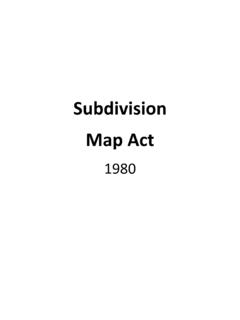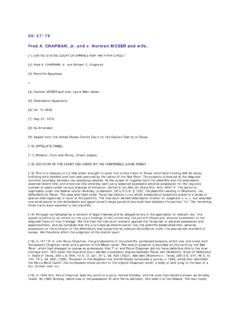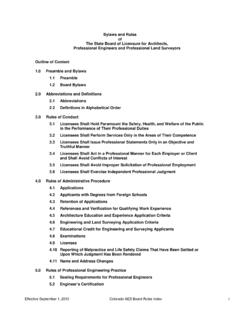Transcription of OFFICE OF THE ATTORNEY GENERAL OF CALIFORNIA
1 OFFICE OF THE ATTORNEY GENERAL OF CALIFORNIA Opinion No. CV 78 43 61 Op. Atty Gen. Cal. 466 November 3, 1978 SYLLABUS: [*1] COUNTY RESPONSIBILITY FOR PUBLIC ROADS A county may accept an offer of dedication of roads for public use without accepting the responsibility of maintenance if the acceptance precedes the roads becoming part of a county highway system, and, while approving subdivision, may accept dedication of roads, requiring that the association of subdivision parcel owners maintain the roads if the acceptance is made before the roads become part of the county highway system. A non exclusive easement for road and utility purposes obtained by a private individual and appurtenant to his land may not be dedicated to a county for public use if the original grant of the easement did not consider public use.
2 However, under the same conditions, a non exclusive easement for road and utility purposes may be dedicated to a county for public use if the original grant of the easement was for "public road and utility purposes" or for "public and private purposes." OPINION BY: EVELLE J. YOUNGER, ATTORNEY GENERAL (Rodney Lilyquist, Jr., Deputy) OPINION: Requested by: COUNTY COUNSEL, PLACER COUNTY The Honorable L. J. DeWald, County Counsel of the County of Placer, has requested an opinion on the following questions: 1. May [*2] a county accept an offer of dedication of roads for public use without accepting the responsibility of their maintenance? 2. In the process of subdivision approval, may a county accept an offer of dedication of roads and require that the roads be maintained by the association of the subdivision parcel owners?
3 3. May a non exclusive easement for road and utility purposes obtained by a private individual and appurtenant to his land be dedicated to a county for public use if the original grant of the easement was not expressly for public use? 4. May a non exclusive easement for road and utility purposes obtained by a private individual and appurtenant to his land be dedicated to a county for public use if the original grant of the easement was for "public road and utility purposes" or for "public and private purposes"? The conclusions are: 1. A county may accept an offer of dedication of roads for public use without accepting the responsibility of their maintenance prior to the roads becoming part of the county highway system. 2. In the process of subdivision approval, a county may accept an offer of dedication of roads and require that the roads be maintained by the association [*3] of subdivision parcel owners prior to the roads becoming part of the county highway system.
4 3. A non exclusive easement for road and utility purposes obtained by a private individual and appurtenant to his land may not be dedicated to a county for public use if the original grant of the easement did not contemplate public use. 4. A non exclusive easement for road and utility purposes obtained by a private individual and appurtenant to his land may be dedicated to a county for public use if the original grant of the easement was for "public road and utility purposes" or for "public and private purposes." ANALYSIS The Subdivision Map Act (Gov. Code, @@ 66410 ) (hereinafter referred to as the Act) is a part of the enabling statutory scheme for local supervision of subdivision developments. In GENERAL terms, it requires a land subdivider to file, to get approval of, and to record a subdivision map with the local governing body; anyone who offers to sell or lease any part of a subdivision without complying with the Act is subject to criminal sanctions.
5 (Bright v. Board of Supervisors (1977) 6 Cal. App. 3d 191, 193 194; 61 Ops. Cal. Atty. Gen. 114, 115 (1978); [*4] Comment, Review of Selected 1974 CALIFORNIA CALIFORNIA Legislation (1975) 6 Pacific 125, 357 360; Comment, Forced Dedication as a Condition to Subdivision Approval (1971) 9 San Diego 112, 112.) With certain exceptions, the specific requirements of the Act placed upon a subdivider are: (1) to design the subdivision in conformity with the local GENERAL or specific plans, (2) to construct public purpose improvements such as streets and sewers, and (3) to donate land or money for public facilities such as schools and parks. (Gov. Code, @@ 66439, 66474 66479; 3 Witkin, Summary of Cal. Law (8th ed. 1973), Real Property, @@ 22 24, pp.)
6 1788 1792; 2 Orden's Revised Cal. Real Property Law (1975) @@ . , pp. 1204 1206; Comment, Land Development and the Environment: The Subdivision Map Act (1974) 5 Pacific 55, 86 87.) The four questions presented for analysis concern proposed subdivisions in a rural county in which the units of land are to be divided into large parcel sizes of three acres or more. Constructing roads that meet county highway standards in such low density subdivisions is relatively expensive and not as necessary as in subdivisions with smaller [*5] parcel sizes. Roads that do not meet county highway standards, however, require greater maintenance. While the county might allow roads of lesser construction standards in such subdivisions, it would prefer that maintenance of the roads not be the responsibility of the county but that the roads be subject to public use rather than private control.
7 The formation of a special road maintenance district (Sts. & Hy. Code, @ ) is considered too expensive an alternative by the county in some situations. The first two questions involve the issue of whether the county or private individuals may be required to maintain roads dedicated for public use, while the last two questions involve the types of roads and utility easements that may be accepted for subdivision approval. A "dedication" is the application of private real property to a public use. (3 Miller & Starr, Current Law of Cal. Real Estate (1977) @ , p. 454; 10 Hagman & Maxwell, Cal. Real Estate Practice (1978) @ , p. 361:4; 1 Ogden, supra, @ , p. 125; 3 Witkin, supra, @ 70, p. 1827.) A dedication may be accomplished by statutory means (generally, complying with the provisions of the Act) or by nonstatutory, [*6] common law methods.
8 (People v. Rio Nido Co. (1938) 29 Cal. App. 2d 486, 492; 3 Miller, supra, @ , pp. 454 455; 10 Higman, supra, @ (2), p. 361:6; 1 Ogden, supra, @ , pp. 125 128.) Both an offer and an acceptance are required to effectuate a dedication; the offer may be accepted by a formal resolution of the governing body that has jurisdiction over the property or by informal public use or other governmental action. (3 Miller, supra, @ , pp. 480 481; 10 Hagman, supra, @ (1)(4), pp. 361:36 41.) The significance of accepting an offer of dedication is that the property is thereafter held in trust for public use; the property is no longer subject to private control. (10 Hagman, supra, @ (3), p. 361:6.) It does not follow, however, that property open to public use must be maintained by the governing body that accepted the offer of dedication.
9 Although a road is a "public street" and subject to "public control," it need not necessarily be maintained by the local governing entity. All roads over which the public has a right to travel, whether express or prescriptive, are "public" roads. "Public" roads, however, are [*7] not "county" roads until accepted as such by appropriate resolution of the board of supervisors. (Sts. & Hy. Code, @ 941; 45 Ops. Cal. Atty. Gen. 98, 100 (1965).) The GENERAL rule is that a county may not use county road funds for maintaining "public" roads other than "county" roads. (45 Ops. Cal. Atty. Gen. supra, 98, 100; 7 Ops. Cal. Atty. Gen. 174, 177 (1946); 4 Ops. Cal. Atty. Gen. 112, 113 114 (1944).) Accordingly, a county has no statutory duty to maintain public roads that have not been accepted into the county highway system by resolution of the board of supervisors.
10 (County of Kern v. Edgemont Dev. Corp. (1963) 222 Cal. App. 2d 874, 878 879.) The distinction between "public" roads and "county" roads is made exceedingly clear by Streets and Highways Code section 941, the second paragraph of which states: "No road shall become a county highway until and unless the board of supervisors, by appropriate resolution, has caused said road to be accepted into the county road system; nor shall any county be held liable for failure to maintain any road unless and until it has been accepted into the county road system by resolution of the board of supervisors." [*8] n1 n1 Streets and Highways section 1806 provides similar treatment for city streets. Consequently, a two step procedure is required for imposing upon a county the responsibility of maintaining roads dedicated to public use.










